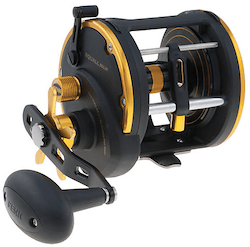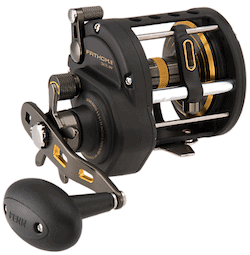Penn Squall Vs Fathom Reels – What Are The Differences, And Which One Should You Buy?
UPDATED 15 MAY 2023
by Robert Ceran
This article may contain affiliate links. If you make a purchase after clicking on a link we may earn a small commission at no extra cost to you.
If you’re currently looking for a high quality conventional reel, then the Squall and Fathom series are among the best models to choose from.
But in order to decide which one of these is right for you, you need to know their main features and differences.
Both reel series come in 4 design variations, and so you not only need to choose between the two series, but also among one of the 4 variants.

For this article we tested the most important features of both reel series, as well their main differences, so you can decide which one is best for your purpose.
Penn Squall vs Fathom reels – what are the differences?
The table above compares the most important specifications and features of both series and their 4 variants that we tested side by side.
As you can see, many of their features are broadly similar, while they also have some key differences.
Let’s dive into the differences revealed by our testing.
The most important differences between the Penn Squall and Fathom series
Build material: This is the category with the biggest difference between the two series.
Bottom line: While the Squall is built with graphite frame and side plates, the Fathom is entirely built with metal.
For small to medium sized fish this doesn’t really make a difference, and graphite is perfectly fine. But if you’re planning to catch big fish that like to fight hard, such as big tuna, sailfish or marlin, it’s essentially to choose the best gear for the job, and metal has a clear advantage over graphite.
Based on our testing, the problem with graphite is that it can be distorted under high pressure, which can cause misalignment of the parts, resulting in a reel that doesn’t perform as smoothly as it should. Metal doesn’t warp even under very high pressure, and so is the best choice for targeting heavyweight fighters.
Bottom line: The Fathom is built entirely with metal, which is better for catching big saltwater fish. However, if you’re targeting smaller species such as wahoo or dolphin, then our testing showed that the graphite reels of the Squall series are absolutely fine, and will serve you well.
Size: Both series are mostly similar in this regard, although there can be minor differences in the range of sizes covered by each of the reel variants.
Weight: The Fathom series tends to be a little heavier than the corresponding Squall models, since it is built with metal instead of graphite. However, if you’re using a heavy boat or trolling rod, then this weight difference doesn’t really matter.
Ball bearings: Both series are broadly similar in this respect, and come with shielded stainless steel ball bearings, which are ideal for withstanding the corrosive conditions of saltwater fishing. However, there are slight differences in the number of ball bearings for each variant. For example, the Fathom Level Wind series has two additional bearings compared to the corresponding Squall series, and when we put it to the test, we found that this gives it smoother action.
Maximum drag pressure: On average, the max pressure is higher on the Fathom series compared to the Squall series. This makes perfect sense, since the former is designed for targeting bigger fish, which fight harder.
Gear ratio: While both series are broadly similar in this category, there are some clear differences between specific variants. For example, the Fathom Lever series tends to have higher gear speeds than the corresponding Squall series. Take a look at the table above to check out these differences.
Now let’s look at each of the series in more detail.
Penn Squall conventional reel

This reel comes in 4 main variants and based on our test results, this is a classic workhorse reel for saltwater fishing. It is usually used for boat fishing, mostly for trolling and deep sea fishing, though the smallest sizes (12 and 15) can also be used for casting.
1. Star Drag variant

This variant allows you to adjust the pressure on a continuous scale with a star knob next to the reel handle.
Features:
- 6+1 shielded ball bearings
- Instant anti reverse with silent backup
- Stainless steel pinion gear
2. Lever Drag variant

This variant gives you four options of pressure to choose from, instead of a continuous spectrum. It’s operated with a lever located next to the reel handle.
Features:
- 6+1 shielded ball bearings
- Forged aluminum spool
- Dura drag system
3. Lever Drag 2 Speed variant

The 2 speed variant allows you to choose between two different retrieval speeds: the usual speed, plus a much slower second one that enables you to “winch” big fish in without having to raise and lower your rod.
During our testing we found that this can be very useful for pulling up big deep sea fish such as groupers and snappers.
Features:
- 2+1 shielded ball bearings
- Quick-shift 2 speed system
- Silent double-dog anti reverse
4. Level Wind variant

This variant has a line guide on the reel that moves from side to side during retrieval, to ensure the line is wrapped evenly on to the spool.
Some anglers prefer not to use this, and instead guide the line back and forth with their thumb.
Features:
- 2+1 shielded ball bearings
- Machined aluminum spool
Penn Fathom conventional reel

Similar to the Squall, this reel series is available in the same 4 variants. When we tested it we found that the main difference that sets it apart from the other series is that it’s built entirely with metal, instead of graphite. During our testing we found that this makes it more durable, and resistant to warping under pressure while fighting a big fish. A magnetic casting brake is available on the smallest sizes (12 and 15).
1. Star Drag variant

On this variant you can use a star shaped knob on the inside of the reel handle to adjust pressure.
Features:
- 6+1 shielded ball bearings
- Fast gear access sideplate
- Versa drag system
2. Lever Drag variant

On this variant the pressure is adjusted with a lever that comes with several predetermined options that you can select.
Features:
- 4+1 shielded ball bearings
- Stainless steel pinion gear
- Dura drag system
3. Lever Drag 2 Speed variant

This reel allows you to choose between 2 retrieval speeds: a high speed normal gear setting, plus an extra slow setting which we found is ideal for pulling up big fish with torque alone, instead of having to raise and lower your rod in order to retrieve line.
Features:
- 4+1 shielded ball bearings
- Quick-shift 2 speed system
- Double-dog ratchet anti reverse
4. Level Wind variant

On this variant a line guide helps to spool line evenly during retrieval, to avoid build up on one side of the spool.
Some anglers like this feature, while others prefer to use their thumb for it. Also, it’s less important if you’re using braid, since that tends to spool evenly by itself.
Features:
- 4+1 shielded ball bearings
- Fast gear access side plates
- Line capacity rings
Penn Warfare vs Squall
Another Penn reel lineup similar to the Squall is the Warfare reel series, which is slightly more affordable.
When compared side by side, it’s clear that the drag system of the Squall is stronger, and comes with higher max drag pressure.
Also, the pinion gear of the Squall is made of stainless steel, while that of the Warfare is made of bronze.
Finally, the retrieval action of the Squall is slightly smoother than that of the Warfare, and the knob of the handle is soft EVA plastic, while the knob of the handle on the Warfare is hard plastic.
Conclusion
Penn conventional fishing reels are among the most popular models used by saltwater anglers across the globe. Penn fishing has specialized in building heavy duty models that stand up to the relentless strain of catching big fish in corrosive saltwater conditions.
In summary: our testing revealed that both Penn reel series are very high quality options for trolling and deep sea fishing, and can be used for many of the same applications. In addition, the smallest sizes come with magnetic casting brakes, and can be used for surf casting.
The most important difference that sets the Fathom apart is that it is built entirely with metal, while the Squall is mostly built with graphite.
Since metal is more durable and less prone to warping under high pressure, this makes the Fathom a better choice for fighting extra big fish.
Materials and gear used for testing
For consistent testing results, we paired all of the reels that we tested for this review with the same rod, a 6′ Extra Heavy power Fast action Shimano Tallus Roller Fishing Rod. The reels were spooled with 40 lb test Power Pro braided line, and we tested them by trolling for King Mackerel and Blackfin Tuna in Tampa Bay.








